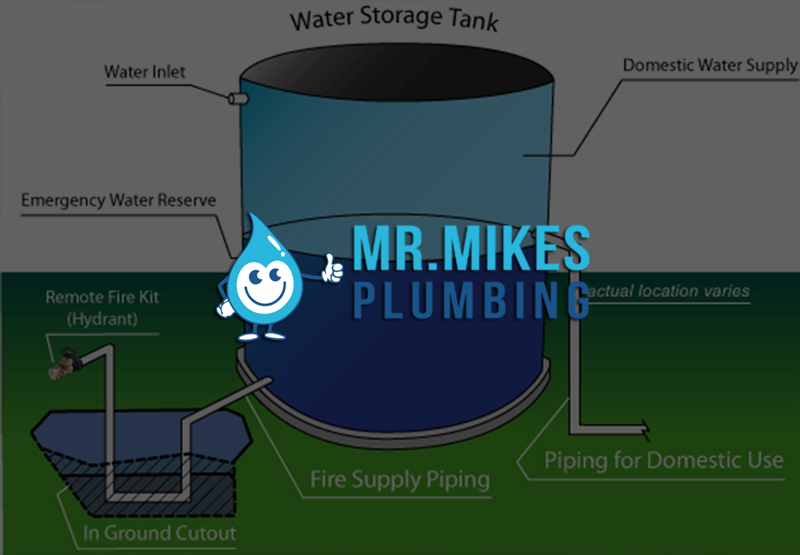
More about water pumps
February 8, 2017
The public water supply
February 10, 2017When the pressure in a water supply is irregular, uncertain, or intermittent, some method is necessary to obtain water in the plumbing system when the pressure in the water supply is low. Two principal methods are used:
- A gravity storage tank
- A pneumatic storage tank
Gravity storage tanks
The gravity storage tank is placed at an elevation above all points where water is needed; it may be on the roof, in the attic, on a tower, or on a hill. In very tall buildings gravity storage tanks are placed on intermediate floors to minimize the pressures on the lower floors. During periods of high pressure in the water-supply system, such as might occur when the pumps are running, or the windmill is operating, or the pressure is increased in the public supply, water is delivered into the storage tank.
When the pressure in the water supply is reduced water will flow from the storage tank into the pipes of the plumbing system. The tank must be equipped with an automatic valve, usually controlled by a float, to shut off the supply when the tank is full, and with an overflow of sufficient capacity to carry off water faster than it can be supplied to the tank.
The top of the overflow pipe should be at least 3 in. below the top of the tank and no air vent should be inserted in the overflow pipe. If the tank is placed above a building, provision must be made to conduct away leakage or, in case of the failure of the tank, to conduct the water away quickly without damage to the building. The tank should be provided, also, with a telltale to indicate when the tank is full, a distributing pipe to furnish water from the tank to the pipes in the building, and a drain pipe through which the tank can be emptied.
Outside storage tanks, whether of wood or of metal, should have a weathertight and fireproof roof so arranged as to exclude birds. The purpose of the roof is to protect the water from inevitable pollution by birds, dust, and dirt in the air and to aid in preventing the formation of ice. The roof must not be airtight. It must be vented so as to permit the rapid filling or emptying of the tank without the creation of a pressure or a vacuum under the roof. In any outside tank an expansion joint should be used on any pipe passing through the tank.
The water supply to a storage tank may come through the same or a different pipe than the pipe used to deliver water from the tank. If separate pipes are used the incoming water pipe may rise outside or inside of the tank. An outside location makes repairs easy but exposes more of the pipe to freezing temperatures.
The size of a gravity storage tank is dependent on the demand for water between periods of high pressure in the water supply. It can be determined only by local conditions and generalizations can be only suggestive. In such extreme situations where pressure is available during the night only and the entire day’s supply must be stored in the tank, there should not be less than 80 gal. for each person depending on the tank for supply.
Too large a tank, however, may result in complaints of the quality of the water due to the generation of odours, too high a temperature, or other difficulties arising from too long a period of storage.
Gravity storage tanks are made of wood, metal, and in some cases of concrete. The woods commonly used are cypress, red cedar, white pine or Oregon pine (Douglas fir), and red pine (redwood). The tank is made up of wood staves which are held together by round iron hoops. Round hoops are better than flat hoops as they can be easily examined when in place and can be more easily protected by paint and there is less surface exposed to the atmosphere than for any other shape containing the same quantity of metal.
Welded or upset hoops should not be used because of danger from weakness in the weld. The hoop ends are joined by means of a lug. In placing the hoops on a tank the lugs should not be placed in the same vertical line. Wooden tanks are less expensive than metal tanks in first cost; they will last, with care, for 12 to 30 years; they furnish better protection against freezing; they require less skill in erection; and they do not sweat. Metal tanks will usually outlast wooden tanks and there is less likelihood of leakage from them.
Possible objections to the use of gravity tanks in a building include the extra weight to be supported by the frame of the building, the cost of the tower if placed elsewhere than on a building or a hill, possible contamination of the water or change in its quality, the possible freezing of the water, and other difficulties. These can all be overcome, but at somewhat increased expense, by the use of a pneumatic storage tank.
Pneumatic storage tanks
A pneumatic storage tank is a closed airtight tank filled partly with water and partly with air. The inlet and outlet pipes for the water enter through the bottom of the tank. Compressed air is pumped into the tank through an air pipe at the top. In the operation of the tank water is pumped into it thus compressing the air entrained until the tank is about two-thirds full of water. Additional compressed air is then forced in over the top of the water.
A check valve in the inlet pipe prevents the backflow of water into the pipes supplying water to the tank. When the pressure in the water supply lines becomes low the pressure due to the compressed air in the tank furnishes the necessary force to move water to the points desired in the plumbing system. An air compressor is necessary to supply the initial air pressure and to make up for the loss of air from the tank. This loss may be appreciable because the pressure on the water entering the tank is increased thus rendering air more soluble in it. The solubility of gases in water increases with the pressure.
Wide variations in pressure are undesirable and uneconomical but are unavoidable with this type of storage. The same principles with regard to the capacity hold for pneumatic tanks as for gravity storage tanks. The effective capacity of water storage is taken as two-thirds of the full capacity of the tank.



